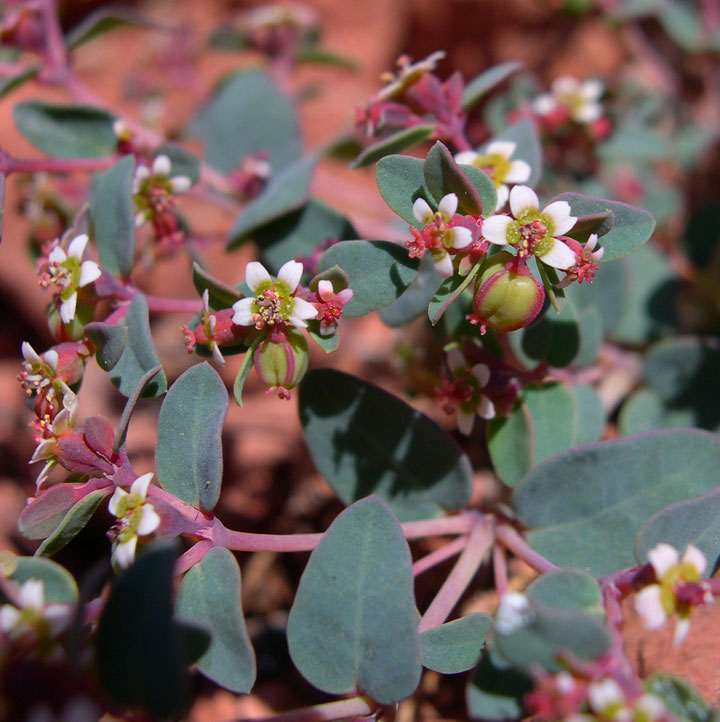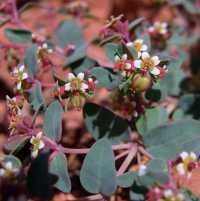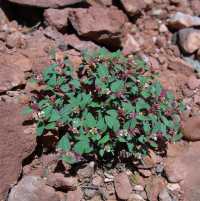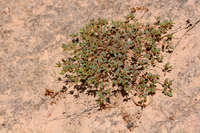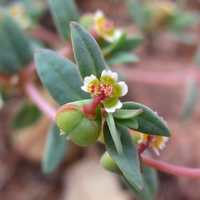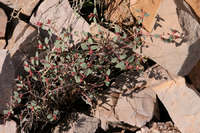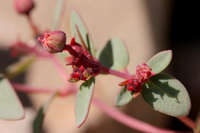Duration: Perennial
Nativity: Native
Lifeform: Subshrub
General: Low growing perennial herbs, to 15 cm tall, from a branched, underground woody caudex and deep-seated taproot; stems several, usually erect to decumbent but sometimes prostrate, slender or wiry, often red to purple; herbage glabrous.
Leaves: Opposite along the stems, on petioles less than 1 mm long; blades lanceolate to ovate, 3-11 mm, long with slightly asymmetric bases and entire margins; stipules distinct, bristle or awn-like, 1 mm long.
Flowers: Has the highly modified flower structure characteristic of Euphorbias. Structures called cyathia appear to be individual flowers, but are composed of fused-together bracts forming a cup (involucre), with peripheral nectary glands which are often subtended by petal-like bracts called petaloid appendages. Within the cup there is a ring of inconspicuous male flowers, each reduced to a single stamen. Out of the middle protrudes a single, stalked female flower which lacks petals. In E. fendleri, the cyathia (flower-like structures) are solitary in the leaf axils. Involucres are bell-shaped to top-shaped, 1.5 mm high, and glabrous, with 4 green-yellow to reddish oblong glands around the edge, each with a white petaloid appendage (appendages sometimes absent); 25-35 staminate flowers.
Fruits: Capsules subglobose, to 2.5 mm long, 3-celled, nodding; containing 3 white quadrangular seeds, 2 mm long, smooth to slightly wrinkled.
Ecology: Found in sandy and gravelly soils, in deserts, shrublands, woodlands, and ponderosa pine forests; sometimes on roadsides or dry cracks in limestone; from 2,000-8,500 ft (601-2591 m); flowers May-September.
Distribution: SD to TX, west to CA, NV and AZ
Notes: This species belongs to the Chamaesyce subgenus of Euphorbia. Some treatments, even recent ones, treat Chamaesyce as a separate genus even though molecular evidence places it within Euphorbia. Chamaesyce spp are distinct based on their leaves which are always opposite and and often have asymmetric bases; cyathia (flower structures) in leaf axils, not at branch tips, and usually with petaloid appendages; and stipules present and not gland-like. E. fendleri is distinguished by being a perennial with glabrous (hairless) stems, leaves, and seed pods; ovate leaves 3-11 mm long with a pair of narrow bristle-like stipules at the base of each; petaloid appendages sometimes present and sometimes absent; and white, quadrangular seeds. Allred and Ivey recognize 2 varieties: var. fendleri has ovate to nearly orbicular leaf blades, and var. chaetocalyx has narrower lanceolate to lance-ovate leaf blades. FNA recognizes var. chaetocalyx as a distinct species but acknowledges that it intergrades with E. fendleri in Arizona, New Mexico, and Texas. Distinguish from E. albomarginata based on the stipules which are united in that species and distinct and bristle-like in E. fendleri. It is wise to make a collection whenever ID to species is needed, as Chamaesyces are difficult to identify in the field, and multiple species of the genus will commonly grow side-by-side.
Ethnobotany: Used medicinally to treat stomachaches, diarrhea; applied topically to treat poison ivy, warts, toothaches, cuts, and to stimulate a mother's milk production; young roots were fed to sick babies whose mother's milk was failing.
Etymology: Euphorbia is named for Euphorbus, Greek physician of Juba II, King of Mauretania; fendleri honors for August(us) Fendler (1813-1883), a German plant collector in North and Central America.
Synonyms: Chamaesyce fendleri
Editor: LCrumbacher 2012, AHazelton 2017
Plant: Perennial; stem decumbent, glabrous; sap milky
Leaves: cauline, opposite, short-petioled, 3-11 mm; stipules separate, linear, entire; blade ovate, glabrous, tip acute, margin entire
INFLORESCENCE: flower-like, generally 1 per node; involucre < 2 mm, bell-shaped to obconic, glabrous; gland < 1 mm, elliptic; appendage narrower than gland, scalloped, white
Flowers: Staminate flowers 25-35, generally in 5 clusters around pistillate flower, each flower a stamen; Pistillate flower: 1, central, stalked; ovary chambers 3, ovule 1 per chamber, styles 3, style divided 1/2 length
Fruit: capsule, 2-2.5 mm, ovoid, lobed, glabrous; Seed 2-2.5 mm, ovoid, smooth to slightly wrinkled, white
Misc: Dry slopes, woodland; 1500-2300 m.; May-Oct


